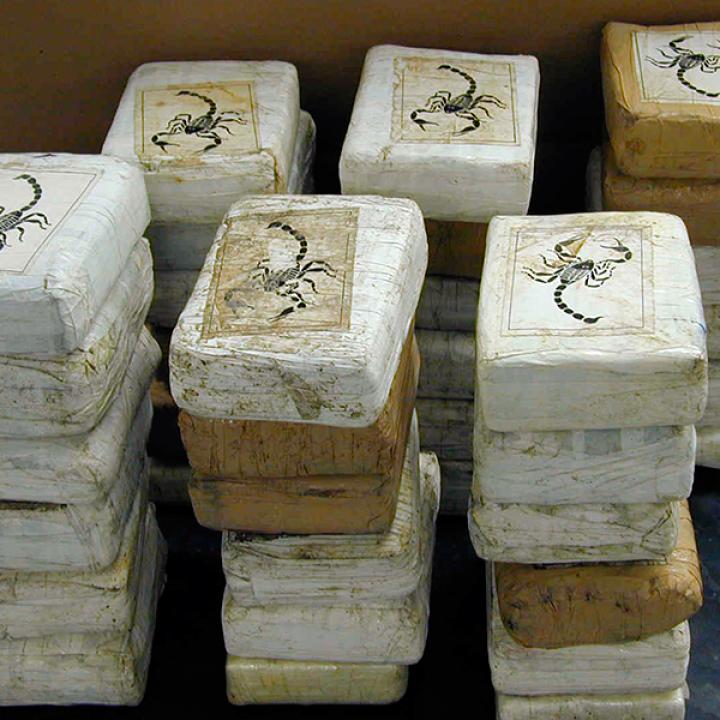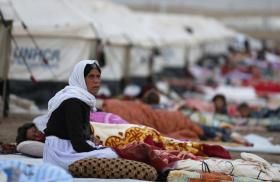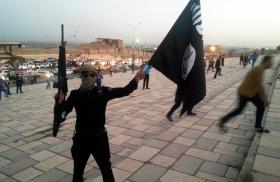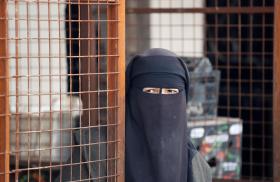
- Policy Analysis
- PolicyWatch 3240
The DEA's Targeting of Hezbollah's Global Criminal Support Network

Part of a series: Counterterrorism Lecture Series
or see Part 1: U.S. Efforts against Terrorism Financing: A View from the Private Sector
The head of the Counter-Narcoterrorism Operations Center discusses how the group uses drug trafficking and other schemes to fund its activities, and what the DEA is doing to stop it.
On January 9, John Fernandez addressed a Policy Forum at The Washington Institute. As the Drug Enforcement Administration’s assistant special agent in charge of the Special Operations Division’s Counter-Narcoterrorism Operations Center, he oversees interagency support to field investigations concerning Hezbollah’s global criminal support structures. The following is a rapporteur’s summary of his remarks.
As part of an effort to bring together the intelligence, law enforcement, and military communities in the fight against narcoterrorism and money laundering linked to terrorist organizations, the DEA established the Counter-Narcoterrorism Operations Center in the wake of the September 11 attacks. Today, CNTOC plays two primary roles. First, it shares non-drug-related terrorism information generated from its global operations with the FBI and other agencies that have primary investigative authorities for that information. Second, it conducts its own investigations at the nexus of narcotics and terrorism, focusing on “convergence targets” such as money launderers and sanctions violators.
Of the sixty-eight groups designated as Foreign Terrorist Organizations by the State Department, the DEA has linked twenty-five of them to the drug trade. The legal provisions included in 21 U.S.C. 960a have proven useful in expanding the agency’s authorities to target narcoterrorists, and although DEA cases do not always result in terrorism-related charges, the agency uses the evidence and means at its disposal to determine the most easily prosecutable offenses.
The DEA has the largest U.S. law enforcement presence overseas and an extensive source network, both of which have helped collect intelligence on terrorist tactics like the use of improvised explosive devices in Afghanistan, as well as organizations such as Lebanese Hezbollah, the Taliban, the Islamic State, the Revolutionary Armed Forces of Columbia (FARC), and Colombia’s National Liberation Army (ELN). Moreover, a DEA source was critical in foiling the 2011 Iranian plot to kill Saudi ambassador Adel al-Jubeir in Washington. (Iranian American suspect Mansour Arbabsiar had attempted to hire a DEA informant whom he believed to be a member of the Zetas drug cartel to conduct the assassination.)
Hezbollah is a unique target for the DEA due to several characteristics: its high level of sophistication; its hierarchical, compartmentalized structure; its combination of widespread political, military, criminal, and social activities; and its deadly targeting of Americans (prior to the September 11 attacks, Hezbollah had killed more Americans than any other FTO). Today, the Trump administration considers Hezbollah a high national security priority and has spearheaded a robust, cross-government effort aimed at stifling its activities.
Hezbollah’s criminal support network dates to the 1990s, when Imad Mughniyah, head of the group’s External Security Organization, sought to establish a supplemental source of funding besides the money it received from Iran. This criminal network expanded even further as a result of financial burdens incurred during the 2006 Lebanon war.
The DEA’s targeting of Hezbollah began about thirteen years ago with Operation Titan, which intercepted the sale of multi-ton cocaine shipments by Hezbollah associates in cooperation with the Colombian drug cartel La Oficina de Envigado. Notable cases since then have included Lebanese Colombian drug kingpin Ayman Joumaa and the Lebanese Canadian Bank.
In the past six years, the DEA provided assistance that led to the arrests of a number of prominent actors in Hezbollah’s global criminal support network, including Ali Fayyad (2014), Ali Koleilat (2014), Altaf Khanani (2015), Hassan Mansour (2015), and Ibrahim Ahmadoun (2015). In 2016, Operation Cedar targeted an international money laundering scheme, leading to the arrests of Hezbollah operative Mohamad Noureddine and others via concurrent raids in Belgium, France, Germany, and Italy. CNTOC financial investigators also played a central role in the arrest and indictment of Kassim Tajideen, a Hezbollah financier sentenced to five years in prison and ordered to forfeit $50 million in August 2019.
In all, relevant DEA field investigations have spanned six continents and focused extensively on individuals in Europe, Mexico, the Tri-Border Area, Venezuela, and West Africa. Since 2017, DEA efforts on this front have collectively resulted in seventeen indictments, fourteen arrests, three extraditions, and nine designations of Hezbollah-linked individuals through the Treasury Department’s Office of Foreign Assets Control (OFAC). In addition, there are four pending arrests, eight pending indictments, and four pending extraditions on the near horizon.
Hezbollah increasingly relies on criminal revenue streams from a wide array of sources that include the Lebanese diaspora, group members, affiliates, sympathizers, and unwitting collaborators. The organization has even competed for money laundering contracts in the same manner as Colombian cartels and other criminal organizations. OFAC designations are therefore an especially useful tool in targeting Hezbollah supporters. Whether singly or introduced concurrently with a criminal indictment (the most potent option), they help stymie revenue streams, isolate Hezbollah from its associates, provide a basis for criminal charges, and discredit the group’s leadership.
The degree to which Hezbollah values criminal proceeds and fears the idea of operatives being placed under U.S. custody is apparent in the pressure that the group and Iran have placed on governments that take action against such operatives. For example, after drug and arms traffickers Ali Fayyad, Khaled Merebi, and Faouzi Jaber were arrested in the Czech Republic in 2014, individuals related to Fayyad kidnapped five Czech military officers in Lebanon. The officers were returned in exchange for Fayad and Merebi’s release.
In 2017, operative Ali Koleilat was extradited from Belgium to the United States after intelligence uncovered Hezbollah plots aimed at securing his release. Among these threats were plans to assassinate the prosecutors involved in his case and kidnap a Belgian defense attache in Beirut.
That same year, Iran-related elements allegedly sought to bribe the Moroccan government after it arrested Kassim Tajideen. To their credit, the Moroccans resisted Iranian political pressure and expedited his extradition to the United States. Partly due to this decision, Tehran severed diplomatic ties with Rabat in 2018.
Regarding the amount of Hezbollah’s revenue obtained through criminal ventures, a precise figure is unknown, but unofficial estimates have placed it as low as 10 percent. Yet success can be further measured through fallout information on Hezbollah’s lost revenue, impediments to its capabilities, loss of morale, and reputational costs.
As for interactions with U.S. foreign partners, the DEA works closely with numerous countries on these issues. Because many European partners still have not designated Hezbollah as a terrorist organization in its entirety, the agency has found it constructive to leave out the terrorist label in briefings. Referring to Hezbollah’s drug/arms trafficking and money laundering activities while sidestepping terrorism helps avoid political sensitivities. Yet complications sometimes arise in messaging after arrests. For example, the United States wanted to highlight Hezbollah’s links in press releases about Operation Cedar, to the chagrin of several European allies.
Regarding Hezbollah’s relationship with Iran’s Islamic Revolutionary Guard Corps (IRGC), the criminal activities carried out by the two organizations often overlap. Like Hezbollah, Iran has turned to criminal revenue streams to offset the financial constraints imposed by U.S. Treasury sanctions and its own expenditures on proxy wars. Additionally, the DEA has received information on Iranian embassies being used in furtherance of Hezbollah criminal enterprises. For example, diplomatic pouches have reportedly been used to transport narcotics at times. And while Iran is Hezbollah’s principal funder, the group’s illicit proceeds are sometimes used to line Iran’s coffers.
In Syria, Hezbollah has used its drug proceeds to buy arms for fighters on behalf of the Assad regime, with senior commander Ali Fayyad and another individual believed to be involved in the purchases. Hezbollah also protects smuggling routes in the so-called Shia Crescent, including in Syria. Reporting indicates that marijuana, Captagon, and other drugs are now being heavily trafficked by Syrian military intelligence.
Officials at the top of Hezbollah’s hierarchy have given a green light to, turned a blind eye to, and/or actively directed many of these criminal activities, including security chief Wafiq Safa and Abdallah Safieddine, the group’s representative to Iran and cousin to leader Hassan Nasrallah. The fact that Nasrallah has the ability to rein in these individuals but has chosen not to underscores how significant criminal revenue has become to the terrorist organization.
This summary was prepared by Samantha Stern.





